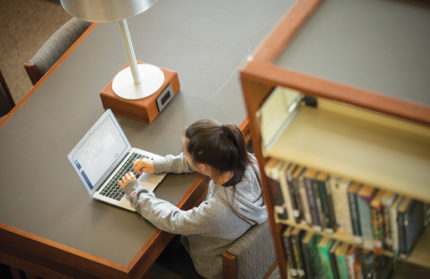Digital Danger
Keeping our kids safe on the web and social media
Technology. It cuts both ways. It can offer information, safety and community. Or it can be dangerous, especially for school-age kids. Fifty years ago, we asked, “Is our child old enough to drive?” Now our question: “Is she old enough to have a smartphone?”
Strangers, privacy, theft, bullying …. The list of on-line perils is lengthy.
As adults, we know how to avoid problems. Our kids, however, are inexperienced and exposed. Meanwhile, our schools struggle to find the right balance of protecting security, openness and youthful curiosity, acting as our partners in this process.
Setting Boundaries
 We expect our schools to help our children learn to handle this new part of life. And they do.
We expect our schools to help our children learn to handle this new part of life. And they do.
But as parents, we have the primary responsibility for teaching our kids to make good choices. We recognize some online activities require our personal involvement. We should talk with our kids about rules and limits for all technology—online chats, shopping, games and other places that are off limits or require parent guidance. Gradually, we can give our maturing children greater latitude before we set them free.
Start by making exploring the web a joint parent-child activity. Use of their phones should initially be only for emergencies or calls to parents. Later, use can expand to known friends. Websites and email can be treated similarly. Again, ease up on the rules gradually.
Some families have contracts with agreed terms for using the web and social media. That may work for your family.
You may want to check your kids’ logs and history. Monitoring may be a useful step in responsible use of technology, and several software packages may be helpful. For instance, Mobile Spy is a useful monitor on kids’ online chats and texts. Quostodio offers a suite of parental controls. FamilyShield is free for PCs, blocking pornography and other tasteless websites.
SafeStudentsOnline, used by Sacred Heart Academy, Archmere Academy, Delaware Valley Friends and several other area schools, monitors students on-line behavior “without spying” on them. There are other tools that also help provide feedabck.
Ideally, you can ease the limits as both you and your kids become experienced with what’s out there.
Personal Safety
You can only restrict your kids’ access to the internet and social media for so long, however. Ultimately, you must deal squarely with the dangers.
Certainly the greatest risk is their personal safety, since kids can communicate with people they and we don’t know—some of whom are bad actors.
The first lesson: our kids must know the person on the other end of a conversation. If not, stop all communication.
Second, our kids shouldn’t send or post private information. Private information—name, address, current location if away from home, and the like—should be just that: private.
Many schools start early teaching kids to navigate online. Sacred Heart Academy, for example, uses Common Sense lessons, available on the web, featuring lessons such as “Going Places Safely” and “Staying Safe Online.” The Haverford School adds to Common Sense with Google’s Be Internet Awesome and iKeepSafe.
The Common Sense lessons are complemented by guest speakers, often from the local police. At The Baldwin School, students heard from the Lower Merion Police department. Sacred Heart Academy students heard from the Radnor Police department, Delaware County District Attorney and U.S. Department of Homeland Security.
Financial Safety
After personal safety, a more common threat is theft. Hackers want numbers for credit cards, bank accounts and the like. To get this information, hackers may assume your child’s on-line identity: name, address, phone number, email and other information.
Your child may have his identity stolen in several ways. For example, by “phishing,” the hacker, posing as someone trusted, may send an email, often with some urgency and a link. Your child clicks the link, and …
That’s it! Invisibly, instantaneously, malware is installed. Your child may be sent to a legitimate-looking website and asked for personal and private information. Preventing malware requires vigilance!
Another form of cyber-attack involves pirating a session-ID: the unique string of code established each time a website is accessed. That website might belong to a friendly classmate or to an online store. Or to anyone, trusted or not. The information transferred on the website, which was supposed to remain confidential, can be intercepted and captured by a hacker, who can use it at will.
Preventing such attacks involves teaching some simple habits for your child to follow. For example, passwords and pin numbers must be complex, regularly changed and kept securely. They must not be disclosed online, by phone, or to an unknown person. Similarly, the student’s identification numbers, such as for social security, accounts and credit cards must be maintained in a secret place and not shared. Every school we interviewed teaches this.
Keeping Private Information Private
The common denominator of online safety is privacy. For a student, an internal alarm should go off whenever she’s asked for private information online. Passwords have been discussed, but privacy of information demands more.
First, ask who’s getting the information and why. Unless it’s a trustworthy website, private information shouldn’t be requested. When interacting with a known retailer or a large well-known organization, you can make a limited exception. But even then, be alert. Check the online contact for spelling: “Amazon” is not “Amizon.” Basically, is the information going to where it is intended to go?
Second, look for “https” (not “http”) on the webpage URL before entering any private information. The “s” is for secure. Don’t send private information except through a secure https website.
Third, only operate a computer behind a firewall. A firewall monitors your network and prevents some on-line traffic from accessing the computer. Your internet service provider probably has a firewall. Most schools have installed firewalls. The computer you use probably has a firewall. Check that it’s turned on.
Fourth, make sure your family has up-to-date anti-spyware. (Anti-virus software includes anti-spyware.) And remind your kids of the basics: Don’t click on unsolicited links and pop-up ads. Don’t download unknown files. And check on your brower’s security settings.
Reputation and Cyber-Bullying
Your 16-year old daughter is despondent. She’s been crying. When you ask what’s wrong, she clams up. You press. And press. Eventually, she pops: she thinks she’s gay. And everyone knows it! That she’s gay — she shared that thought in a private conversation with a close friend-—is all over social media. Someone picked it up and made nasty comments. Now there have been thousands of hits.
Social media magnifies our adventures and misadventures, for better or worse. An indiscretion becomes a scandal. Everyone can be a broadcaster. What was once a confidence to a friend is now available worldwide.
Laura Blankenship, Dean of Academic Affairs at The Baldwin School, says: “It’s often about helping students understand the impact online interactions have and that they feel the same as they would in person. You’re not shielded from the consequences of your words or hurt feelings just because you’re behind a screen…. It’s our job as educators to help them through that.”
In truth, there’s little that can be done once information is “out there.” Once online, messages and photos can be copied and re-transmitted over and over again. The solution is to not put those things online. Have the talk about sexting now, too.
Here education about the openness of the internet can help, as can discussions of “digital citizenship.” In some cases, website operators can take down offensive transmissions to prevent further spreading from that source, though not from others. Sadly, some things can’t be put back in the bottle.
Reconciling Philosophy and Openness
While the dangers of technology are complex, it’s a growing part of life today. As parents, we weigh the dangers. And, in part, we cross our fingers.
Mike Letts, Episcopal Academy’s Head of Upper School, says it’s “crucial” to help students protect themselves and avoid “unhealthy behavior when it comes to online social interaction.” His school’s approach is “constantly evolving.”
The Haverford School’s Director of Information & Instructional Technology, Andrea Drinkwine, says, “We believe education and open dialog, not blanket restrictions, help the Haverford community members understand their role in risk mitigation. We prefer students, teachers and administrators together give careful thought to what is let inside the school walls and what is kept out, what is deemed valuable and what is harmful.”
At Westtown School, Megan McConnolly, formerly Chief Technology Officer, wrestled with the issues for years, recognizing the benefit of computers and phones were in large part due to their openness. A school’s overriding purpose is to teach, and its students to learn. She decided the educational goal had to become its “ethical use.”
Schools are helping. But we all can do more.
Our Favorite Resources
- Berk Hathaway Holly Gross
- Berk Hathaway Country Prop
- Chester Cty Community Fdn
- Chester Cty Hosp, Penn Med
- Chester Cty Library System
- Colonial Theatre
- Delaware Museum of Nat & Sci
- Key Financial, Inc.
- King Construction
- Mercedes Benz
- Osher Lifelong Learning
- Ron’s Original
- Tim Vaughan
- West Chester BID
- Walter J. Cook

